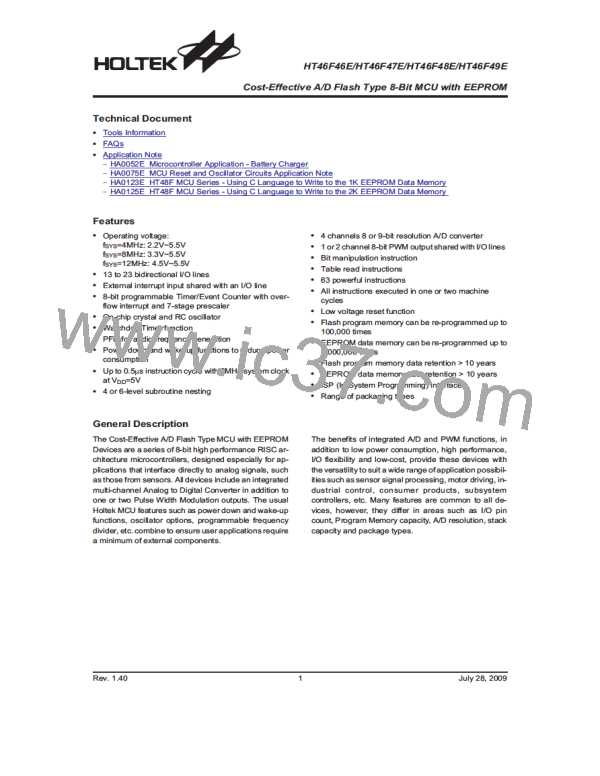HT46F46E/HT46F47E/HT46F48E/HT46F49E
In addition, on entering an interrupt sequence or execut-
setup the control registers to specify which pins are out-
puts and which are inputs before reading data from or
writing data to the I/O ports. One flexible feature of these
registers is the ability to directly program single bits us-
ing the ²SET [m].i² and ²CLR [m].i² instructions. The
ability to change I/O pins from output to input and vice
versa by manipulating specific bits of the I/O control reg-
isters during normal program operation is a useful fea-
ture of these devices.
ing a subroutine call, the status register will not be
pushed onto the stack automatically. If the contents of
the status registers are important and if the subroutine
can corrupt the status register, precautions must be
taken to correctly save it.
Interrupt Control Register - INTC
This 8-bit register, known as the INTC register, controls
the operation of both external and internal timer inter-
rupts. By setting various bits within this register using
standard bit manipulation instructions, the enable/disable
function of each interrupt can be independently con-
trolled. A master interrupt bit within this register, the EMI
bit, acts like a global enable/disable and is used to set all
of the interrupt enable bits on or off. This bit is cleared
when an interrupt routine is entered to disable further in-
terrupt and is set by executing the ²RETI² instruction.
Pulse Width Modulator Registers -
PWM, PWM0, PWM1
Each device in the Cost-Effective A/D Flash Type with
EEPROM microcontroller range contains either one or two
Pulse Width Modulators. Each one has its own related in-
dependent control register. For devices with a single PWM
function this is register is known as PWM, while for devices
with two PWM functions, their control register names are
PWM0 and PWM1. The 8-bit contents of these registers,
defines the duty cycle value for the modulation cycle of the
corresponding Pulse Width Modulator.
Timer/Event Counter Registers - TMR, TMRC
All devices possess a single internal 8-bit count-up timer.
An associated register known as TMR is the location
where the timer¢s 8-bit value is located. This register can
also be preloaded with fixed data to allow different time in-
tervals to be setup. An associated control register, known
as TMRC, contains the setup information for this timer,
which determines in what mode the timer is to be used as
well as containing the timer on/off control function.
A/D Converter Registers -
ADR, ADRL, ADRH, ADCR, ACSR
Each device in the Cost-Effective A/D Flash Type with
EEPROM microcontroller range contains a 4-channel
8-bit or 9-bit A/D converter. The correct operation of the
A/D requires the use of one or two data registers, a con-
trol register and a clock source register. For the
HT46F46E device, which has an 8-bit A/D converter,
there is a single data register, known as ADR. For the
other devices, which contain a 9-bit A/D converter, there
are two data registers, a high byte data register known
as ADRH, and a low byte data register known as ADRL.
These are the register locations where the digital value
is placed after the completion of an analog to digital con-
version cycle. The channel selection and configuration
of the A/D converter is setup via the control register
ADCR while the A/D clock frequency is defined by the
clock source register, ACSR.
Input/Output Ports and Control Registers
Within the area of Special Function Registers, the I/O
registers and their associated control registers play a
prominent role. All I/O ports have a designated register
correspondingly labeled as PA, PB, PC and PD. These
labeled I/O registers are mapped to specific addresses
within the Data Memory as shown in the Data Memory
table, which are used to transfer the appropriate output
or input data on that port. With each I/O port there is an
associated control register labeled PAC, PBC, PCC and
PDC, also mapped to specific addresses with the Data
Memory. The control register specifies which pins of that
port are set as inputs and which are set as outputs. To
setup a pin as an input, the corresponding bit of the con-
trol register must be set high, for an output it must be set
low. During program initialization, it is important to first
EEPROM Control Register - EECR
One special features of this device is that it contains an
area of internal EEPROM Data Memory. EEPROM,
which stands for Electrically Erasable Programmable
b
7
b
0
D
O
D
I
S
K
C
S
E
E
C
R
R
e
g
i
s
t
e
r
N
o
t
i
m
p
l
e
m
e
n
t
e
d
,
r
e
a
E
1
0
E
P
R
O
M
D
a
t
a
M
e
m
o
r
y
:
m
e
m
o
r
y
s
e
l
e
c
t
:
s
t
a
n
d
b
y
E
E
E
E
E
E
P
P
P
R
R
R
O
O
O
M
M
M
S
S
S
e
e
e
r
r
r
i
i
i
a
a
a
l
l
l
C
D
D
l
a
a
o
c
k
t
a
I
t
a
O
EEPROM Control Register
Rev. 1.40
18
July 28, 2009

 HOLTEK [ HOLTEK SEMICONDUCTOR INC ]
HOLTEK [ HOLTEK SEMICONDUCTOR INC ]